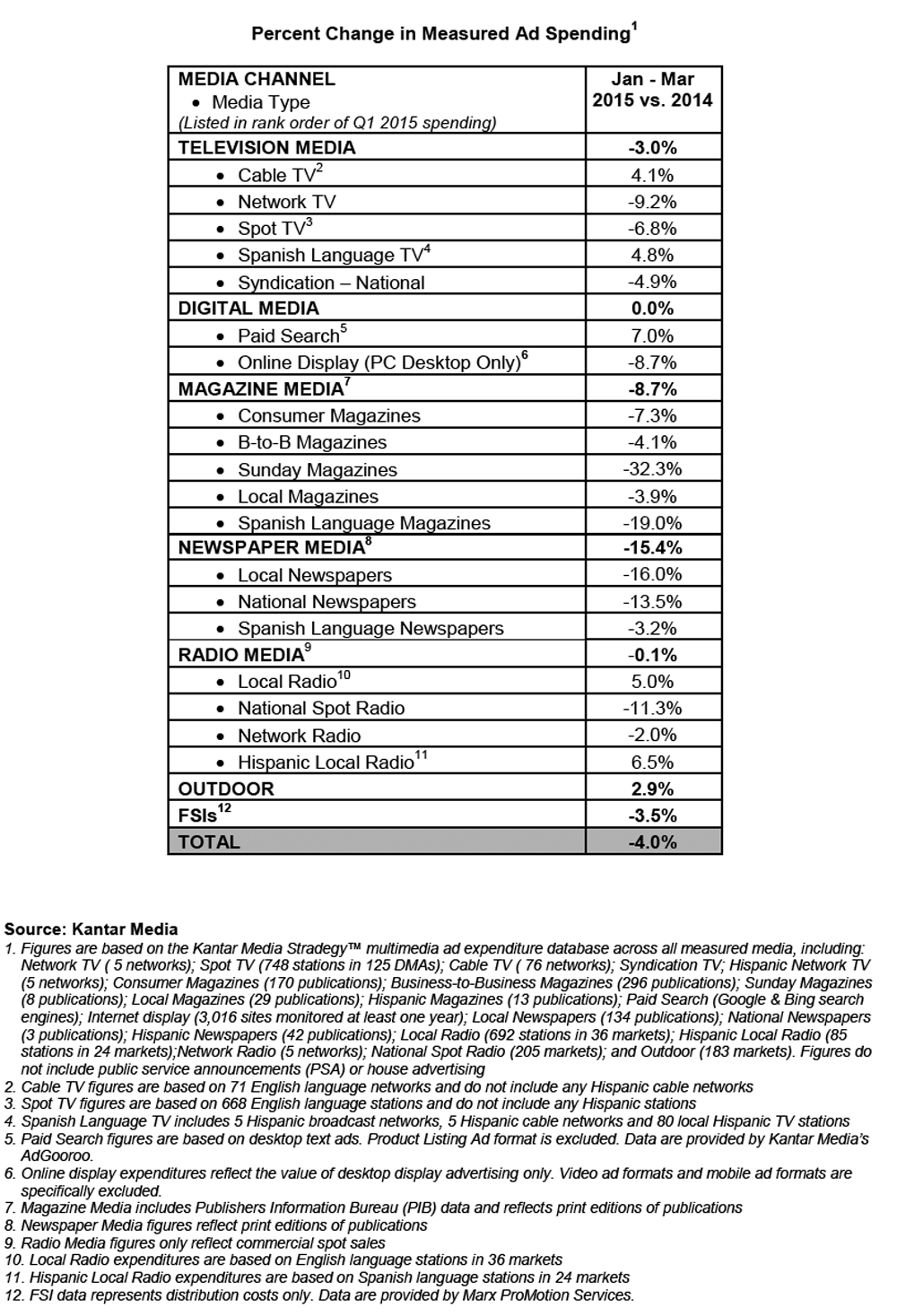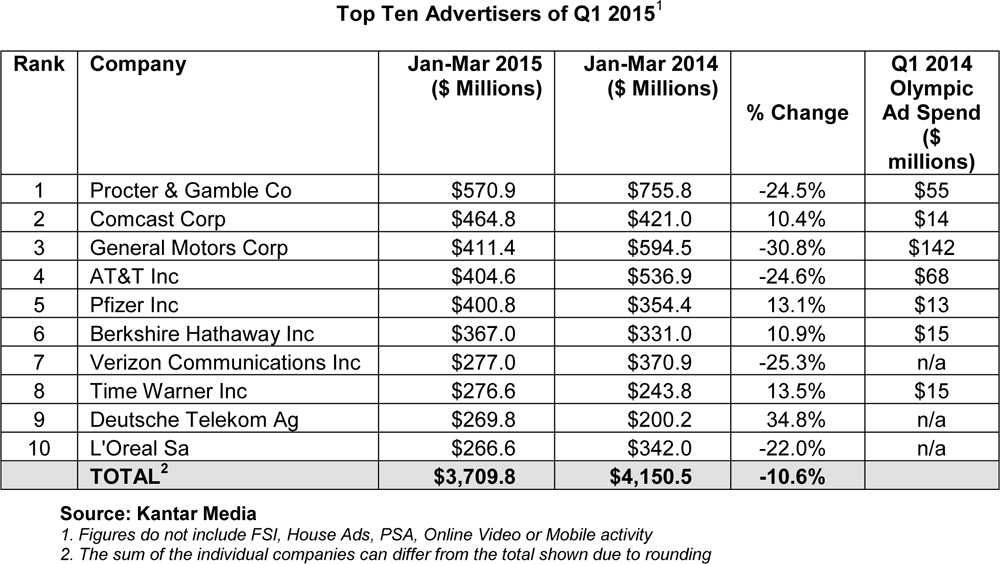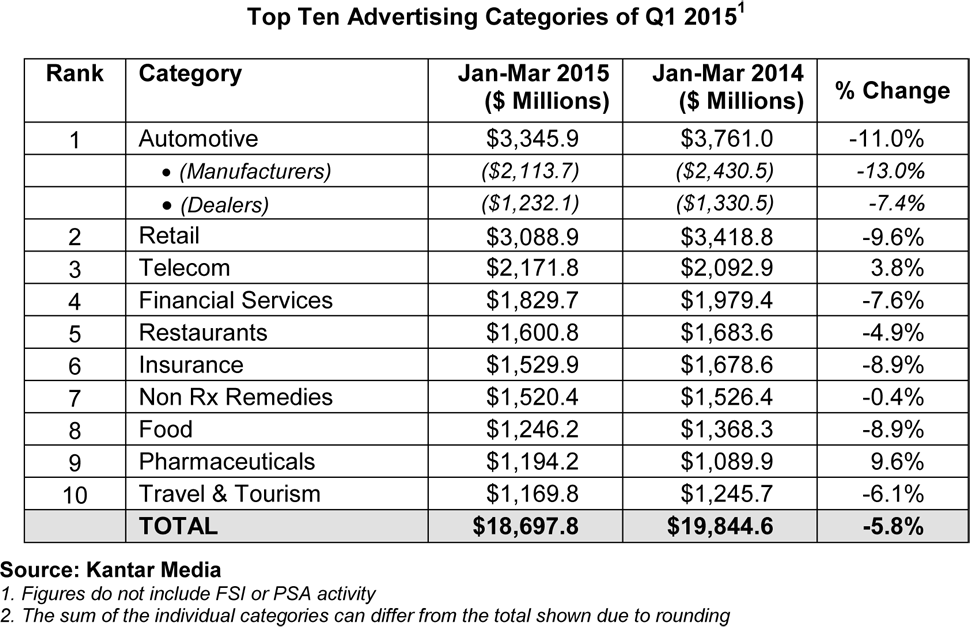Q1 2015 U.S. Ad Expenditures decreases by 4%
June 30, 2015
![]() Total U.S. advertising expenditures declined 4.0 percent in the first quarter of 2015 to $37.4 billion, according to data released by Kantar Media.
Total U.S. advertising expenditures declined 4.0 percent in the first quarter of 2015 to $37.4 billion, according to data released by Kantar Media.
The data includes, for the first time, Paid Search expenditures from Kantar Media’s search marketing intelligence division, AdGooroo. Paid Search advertising has been factored into both the Q1 2014 and Q1 2015 analysis; this data will be included in Kantar Media’s quarterly analysis going forward.
“First quarter results are skewed by comparisons to last year and the $600 million of incremental spend generated by the Sochi Olympics,” said Jon Swallen, Chief Research Officer at Kantar Media North America. “Excluding the impact of special events, core ad spending measured by Kantar Media was down about 2 percent in the period. Even after taking into account assumptions about the growth of spend on other unmonitored media, it has been a relatively slow start for the ad market in 2015.”
Measured Ad Spending By Media
Sixteen of the 21 individual media types monitored by Kantar Media had lower ad spending in the first quarter. These results are consistent with the ongoing shift of ad budgets towards unmeasured digital media, as well as a general slowing of advertising activity.
Among television media, expenditures on Cable networks grew 4.1 percent. A primary reason for the gain was a 3.8 percent increase in the amount of available paid ad time as networks packed more spots into programming to help offset lower audience ratings. The inaugural College Football Playoff in January was another important growth source. Ad spending on Spanish Language TV increased 4.8 percent. The number of national brands purchasing time on Hispanic stations continues to expand and this demand contributes to spending growth.
Network TV expenditures declined 9.2 percent in Q1 compared to a year ago period, which featured the Winter Olympics. If the incremental ad spending contributed by this event is excluded, Network TV was flat versus last year. Spot TV, which has a biennial business cycle tied to Olympics and political advertising in even-numbered years, saw ad spending fall by 6.8 percent. Syndication expenditures were 4.9 percent lower.
Starting with this quarterly report, Kantar Media is including Paid Search in our tabulations of Digital Media. Ad spending for Paid Search, which reflects text ads on the Google and Bing search engines, rose 7.0 percent in Q1. Automotive, financial service, media and retail advertisers led the way. Expenditure for Online Display, which is based upon desktop display ads only and excludes video and mobile ad formats, declined 8.7 percent compared to last year. The main factors were lower CPMs and reduced page traffic. The latter is likely attributable to mobile devices siphoning some desktop usage.
Print media showed a 7.3 percent decline in expenditures for Consumer Magazines, while. ad spending in Sunday Magazines decreased by 32.3 percent in Q1. . Expenditures were down 16.0 percent in Local Newspapers and 13.5 percent in National Newspapers on broadly lower spending among auto, financial, retail and telecom marketers. (Note all figures for print media are based solely on print channels and do not include websites, apps or other properties operated by print publishers).
Radio advertising in Q1 was characterized by gains for the local market sector and declines within the national segment. Hispanic Local Radio expenditures increased 6.5 percent and English-language Local Radio was up 5.0 percent, paced by higher spending from auto dealers, legal services, and health care providers. Network Radio decreased 2.0 percent and National Spot Radio fell 11.3 percent.
Outdoor expenditures rose 2.9 percent in the first quarter. Growth was heavily concentrated in the Top 15 population markets and within this geographic footprint digital signage was a primary driver of higher spending. As we have commented in previous reports, digital inventory gives advertisers more flexibility when purchasing outdoor space and allows operators to earn a higher price.

Measured Ad Spending By Advertiser
Spending by the ten largest advertisers declined 10.6 percent in the first quarter of 2015, to $3,709.8 million. Among the Top 100 marketers, a diversified group accounting for two-fifths of all measured ad expenditures, budgets fell 6.6 percent.
The year-ago period includes the Sochi Winter Olympics and this affects ad spending comparisons for companies that had big positions in the TV coverage of the event. Olympic TV advertisers are noted in the ranking table below.
Procter & Gamble was the largest advertiser in Q1 with media expenditures of $570.9 million, a decline of 24.5 percent. Its measured investments in TV, online display and print media were all lower, which is consistent with recent company statements about shifts in their advertising budgets.
Deutsche Telekom, which controls the T-Mobile wireless brand, had the largest growth rate among the Top Ten. The company increased spending by 34.8 percent to $269.8 million, including a celebrity-focused campaign around the Super Bowl, which introduced the tagline “the Un-Carrier”. By comparison, AT&T reduced its spending 24.6 percent to $404.6 million. Since the May 2014 announcement of its $49 billion merger with DirecTV, AT&T’s annualized rate of ad investment has dropped by $380 million. Verizon Communications lowered its ad spending in Q1 by 25.3 percent to $277.0 million.
Marketing support for a deep list of theatrical movie releases contributed to solid spending increases at Comcast (up 10.4 percent to $464.8 million) and Time Warner (up 13.5 percent to $276.6 million). Pfizer was also prominent, raising expenditures 13.1 percent to $400.8 million. It was the eighth consecutive quarter of year-over-year spending growth for the company.
General Motors was the only automotive company to land in the Top Ten. It spent $411.4 million during the first quarter, a decrease of 30.8 percent compared to the prior year. With the steep drop in gasoline prices spurring the sales of higher-margin SUVs and pickup trucks, GM has rapidly shifted its marketing focus. In Q1 2015 more than 70 percent of its media budget was directed against light trucks compared to 56 percent as recently as the summer of 2014.

Measured Ad Spending By Category
Expenditures for the ten largest categories declined 5.8 percent in the first quarter of 2015 to $18,697.8 million. Eight of the ten categories experienced reductions.
Automotive was the top category with spending of $3,345.9 million, a decrease of 11.0 percent versus last year. Manufacturers raised budgets for truck and SUV models by about 2 percent while slashing expenditures for car models by 20 percent. Dealer spending declined 7.4 percent.
Retail ad expenditures fell 9.6 percent to $3,088.9 million. Higher spending from apparel retailers was more than offset by reductions among consumer electronics and department stores. Insurance category spending was down 8.9 percent to $1,529.9 million as six of the top seven property and casualty underwriters cut back on media advertising.
The Financial Service category reduced its expenditures by 7.6 percent to $1,829.7 million. Credit card marketers continued to pull back on advertising budgets during the quarter, even as consumer credit card debt is on the rise. During the run-up to April 15th tax filing, investment houses spent less money promoting IRA products than last year, while tax preparation services significantly expanded their marketing efforts.
Just two of the ten largest categories posted spending increases in the first quarter. Expenditures for Telecom grew 3.8 percent to $2,171.8 million with robust spending growth from satellite and TV advertisers counterbalancing reduced investments by leading wireless service providers. With the telecom industry heading toward a period of further consolidation, the profile and composition of category ad spending will likely change as a result.
Pharmaceutical advertising expenditures also rose in the period, up 9.6 percent to $1,194.2 million. Well-funded marketing launches for several prescription drugs were responsible for more than one-half of the growth.





























